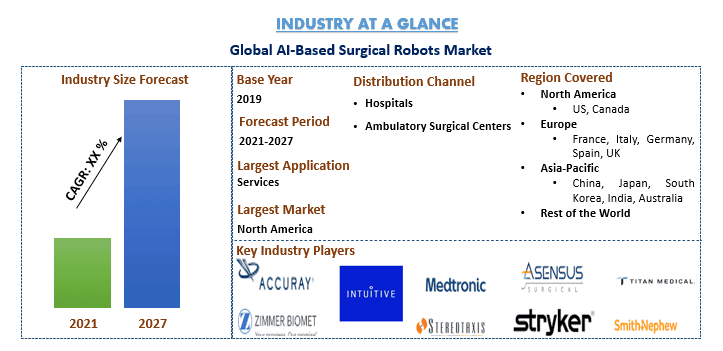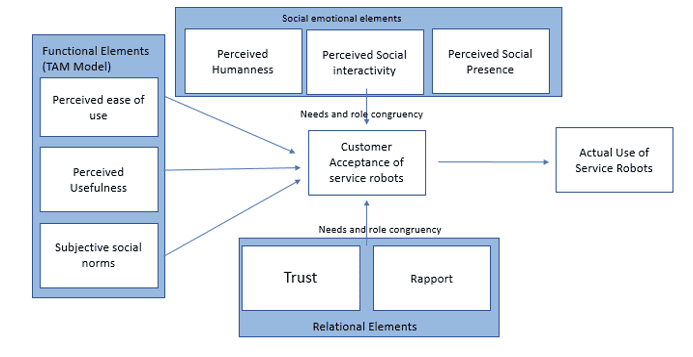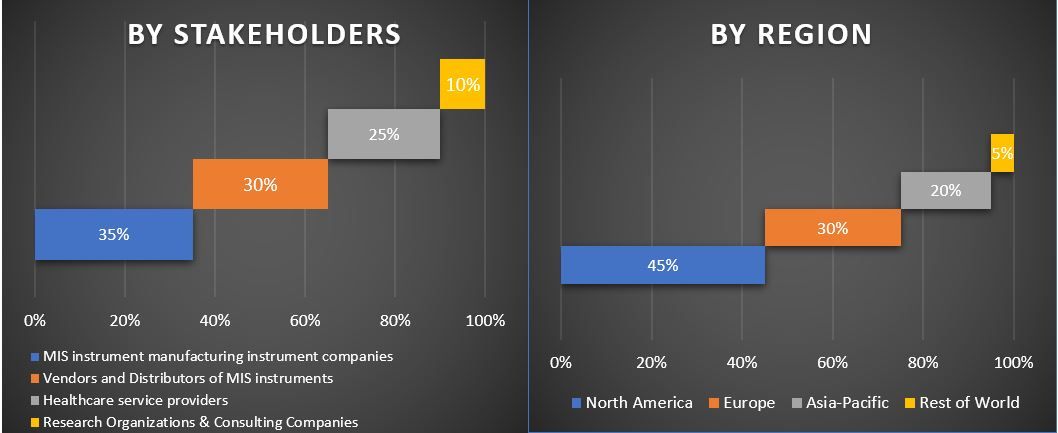- Home
- About Us
- Industry
- Services
- Reading
- Contact Us
AI-Based Surgical Robots Market: Current Analysis and Forecast (2021-2027)
Emphasis on Product Type (Services, Instruments, Accessories), Application (Orthopedics, Neurology, Urology, Gynecology, Others); End-User (Hospitals, Ambulatory Surgical Centres); and Region & Country.

AI-Based Surgical Robots Market was valued at US$ 5 billion in 2020 and is expected to grow at a CAGR of 17% over the forecast period (2021-2027). Robotic surgeries are gaining traction due to the increased efficiency and success rate provided by these surgeries, along with the “minimally invasive” nature of the surgeries. It has increased the penetration of advanced technologies such as artificial intelligence in the field of robotic surgeries, thereby boosting the market growth. A shift in trend from traditional practices of surgical procedures to AI-based approaches by healthcare professionals is also driving the market for AI-based surgical robots. There is an upsurge in the adoption of technologically advanced robots for various applications by surgeons.
For instance, a technologically advanced Da Vinci surgical robot is used for different types of surgeries. In addition, as of 2018, MAKO was used for more than 76,000 knee and hip replacements. The rising adoption of the product for various applications is expected to propel the growth of the market for AI-based surgical robots over the forecast period.
Expanding usage of AI technologies in surgical systems is owing to its advantages that range from the consolidation of databases to intraoperative video analysis this, in turn, is supporting the adoption of AI-based surgical robots. An article published in Annals of Surgery in 2018 stated that AI has proved to be beneficial in assisting radiologists and surgeons in reducing the lumpectomy rate by around 30% among patients having breast needle biopsies. These biopsies considered being high-risk lesions, but after the surgical excision, it has found to be benign. Hence, such instances signify the advantageous nature of artificial intelligence and allied technologies in surgical procedures.
A shift in trend from traditional practices of surgical procedures to AI-based approaches by healthcare professionals is also driving the market for AI-based surgical robots. There is an upsurge in the adoption of technologically advanced robots for various applications by surgeons. For instance, a technologically advanced Da Vinci surgical robot is used for different types of surgeries. In addition, as of 2018, MAKO was used for more than 76,000 knee and hip replacements. The rising adoption of the product for various applications is expected to propel the growth of the market for AI-based surgical robots over the forecast period. Strategic initiatives, such as M&A, product launches, technology upgrades, and partnerships, implemented by the key participants indicate positive movement in the market for AI-based surgical robots.
In 2019, Medtronic launched the technologically advanced Mazor X Stealth robot-assisted spinal surgical platform. In the same year, Stryker Corporation announced the acquisition of Mobius Imaging and its subsidiary Cardan Robotics. In 2020, Accuray Incorporated launched its technologically advanced CyberKnife S7 system, the next-generation CyberKnife platform. These strategic initiatives by key participants are anticipated to drive the market for AI-based surgical robots in the coming years.
Value chain analysis of AI-Based Surgical Robots

are Accuray Incorporated, Intuitive Surgical, Inc., Medtronic, plc, Medrobotics Corporation, Zimmer Biomet, Stereotaxis, Inc., TransEnterix, Inc. Asensus Inc., Stryker Corporation, Activ Surgical, Inc., Titan Medical, Inc., CMR Surgical, Inc., Smith and Nephew, etc., are some of the prominent players operating in the global AI-Based Surgical Robots market.
Insights Presented in the Report
“Amongst Product Type, Service segment holds the major share”
Based on Product Type, the services segment dominated the market for AI-based surgical robots and accounted for the largest revenue share of XX % in 2020. This high share is attributable to the higher cost of maintenance associated with the algorithms of robot-assisted surgery systems. Furthermore, routine technological upgrades and comprehensive service contracts provided to customers by many companies further increases the revenue share.
“Amongst Application, Other’s segment dominated the market during the forecast period”
Based on application, the others segment dominated the market for AI-based surgical robots and accounted for the largest revenue share of XX% in 2020. Other applications mainly include general surgeries, laparoscopy, and ophthalmology, and oncology surgeries. The factors contributing to the high revenue share of the segment include increasing abdominal and oncology-based surgical procedures, coupled with the rising prevalence of breast cancer. In addition, the growing adoption of robots for minimally invasive laparoscopic procedures by surgeons further signifies a higher share.
“Amongst End User, Hospital’s segment dominated the market during the forecast period.”
Based on End User, the AI-Based Surgical Robots market is segmented into Hospitals, and Ambulatory Surgical Centres. The Hospital segment accounted for the largest share in 2020. The large share of this application segment can primarily be attributed to the rising incidence of lifestyle diseases across the globe. Many hospitals are turning toward robot-assisted surgeries (RAS) for clearing the backlog of elective surgeries caused due to COVID-19. As per a Robotic Surgery and Urology consultant in India, there is an increase in the number of patients opting for robotic surgeries since the first wave of the pandemic.
“North America represents one of the largest markets of AI-Based Surgical Robots market.”
For a better understanding of the market dynamics of the AI-Based Surgical Robots market, a detailed analysis was conducted for different regions across the globe including North America (the U.S, Canada, and the Rest of North America), Europe (Germany, France, Spain, United Kingdom, Italy, and Rest of Europe), Asia-Pacific (China, Japan, India, Australia, South-Korea, and Rest of APAC), Rest of World has been conducted. North America dominated the market and generated revenue of US$ XX million in 2020 owing to the rising per capita income.
Reasons to buy this report:
- The study includes market sizing and forecasting analysis validated by authenticated key industry experts
- The report presents a quick review of overall industry performance at one glance
- The report covers an in-depth analysis of prominent industry peers with a primary focus on key business financials, product portfolio, expansion strategies, and recent developments
- Detailed examination of drivers, restraints, key trends, and opportunities prevailing in the industry
- The study comprehensively covers the market across different segments
- Deep dive regional level analysis of the industry
Customization Options:
The AI-Based Surgical Robots Market can further be customized as per the requirement or any other market segment. Besides this, UMI understands that you may have your own business needs, hence feel free to connect with us to get a report that completely suits your requirements.
Table of Content
Analyzing the historical market, estimation of the current market, and forecasting the future market of the Global AI-Based Surgical Robots Market were the three major steps undertaken to create and analyze the adoption of AI-Based Surgical Robots for the different surgeries across major regions globally. Exhaustive secondary research was conducted to collect the historical market numbers and estimate the current market size. Secondly, to validate these insights, numerous findings and assumptions were taken into consideration. Moreover, exhaustive primary interviews were also conducted, with industry experts across the value chain of the AI-Based Surgical Robots sector. Post assumption and validation of market numbers through primary interviews, we employed a top-down approach to forecast the complete market size. Thereafter, market breakdown and data triangulation methods were adopted to estimate and analyze the market size of segments and sub-segments the industry pertains to. Detailed methodology is explained below:
Analysis of Historical Market Size
Step 1: In-Depth Study of Secondary Sources:
Detailed secondary study was conducted to obtain the historical market size of the AI-Based Surgical Robots through company internal sources such as annual report & financial statements, performance presentations, press releases, etc., and external sources including journals, news & articles, government publications, competitor publications, sector reports, third-party database, and other credible publications.
Step 2: Market Segmentation:
After obtaining the historical market size of the AI-Based Surgical Robots market, we conducted a detailed secondary analysis to gather historical market insights and share for different technologies & Equipment types for major regions. Major segments included in the report are Product type, Application, End User and regions. Further country-level analyses were conducted to evaluate the overall adoption of AI-Based Surgical Robots in that region.
Step 3: Factor Analysis:
After acquiring the historical market size of different segments and sub-segments, we conducted a detailed factor analysis to estimate the current market size of AI-Based Surgical Robots. Further, we conducted factor analysis using dependent and independent variables such as the surging demand for AI-Based Surgical Robots. A thorough analysis was conducted for demand and supply-side scenarios considering top partnerships, merger and acquisition, business expansion, and product launches in the AI-Based Surgical Robots industry across the globe.
Current Market Size Estimate & Forecast
Current Market Sizing: Based on actionable insights from the above 3 steps, we arrived at the current market size, key players in the AI-Based Surgical Robots market, and market shares of the segments. All the required percentage shares split, and market breakdowns were determined using the above-mentioned secondary approach and were verified through primary interviews.
Estimation & Forecasting: For market estimation and forecast, weightage was assigned to different factors including drivers & trends, restraints, and opportunities available for the stakeholders. After analyzing these factors, relevant forecasting techniques i.e., bottom-up approach was applied to arrive at the market forecast about 2027 for different segments and subsegments across the major markets globally. The research methodology adopted to estimate the market size encompasses:
- The industry’s market size, in terms of value (US$) and the adoption rate of AI-Based Surgical Robots across the major markets domestically
- All percentage shares, splits, and breakdowns of market segments and sub-segments
- Key players in the AI-Based Surgical Robots market in terms of services offered. Also, the growth strategies adopted by these players to compete in the fast-growing market
Market Size and Share Validation
Primary Research: In-depth interviews were conducted with the Key Opinion Leaders (KOLs) including Top Level Executives (CXO/VPs, Sales Head, Marketing Head, Operational Head, and Regional Head, Country Head, etc.) across major regions. Primary research findings were then summarized, and statistical analysis was performed to prove the stated hypothesis. Inputs from primary research were consolidated with secondary findings, hence turning information into actionable insights.
Split of Primary Participants in Different Regions
Market Engineering
Data triangulation technique was employed to complete the overall market estimation and to arrive at precise statistical numbers of each segment and sub-segment of the AI-Based Surgical Robots market. Data was split into several segments & sub-segments post studying various parameters and trends in the areas of type and product type of the AI-Based Surgical Robots market.
Main Objective of the AI-Based Surgical Robots Market Study
The current & future market trends of AI-Based Surgical Robots were pinpointed in the study. Investors can gain strategic insights to base their discretion for investments from the qualitative and quantitative analysis performed in the study. Current and future market trends were determined the overall attractiveness of the market at a regional level, providing a platform for the industrial participant to exploit the untapped market to benefit as a first-mover advantage. Other quantitative goals of the studies include:
- Analyze the current and forecast market size of AI-Based Surgical Robots in terms of value (US$). Also, analyze the current and forecast market size of different segments and sub-segments
- Segments in the study include areas of application, product type and end-user sector.
- Define and analysis of the regulatory framework for the AI-Based Surgical Robots industry
- Analyze the value chain involved with the presence of various intermediaries, along with analyzing customer and competitor behaviors of the industry
- Analyze the current and forecast market size of the AI-Based Surgical Robots market for the major region.
- Major regions studied in the report include North America (the U.S and Canada), Europe (Germany, France, U.K Spain, and Italy), Asia-Pacific (China, Japan, Australia, South-Korea, and India), Rest of the World
- Company profiles of the AI-Based Surgical Robots market and the growth strategies adopted by the market players to sustain in the fast-growing market
- Deep dive regional level analysis of the industry
Related Reports
Customers who bought this item also bought











